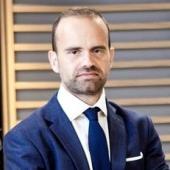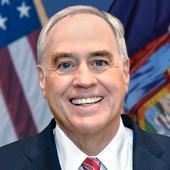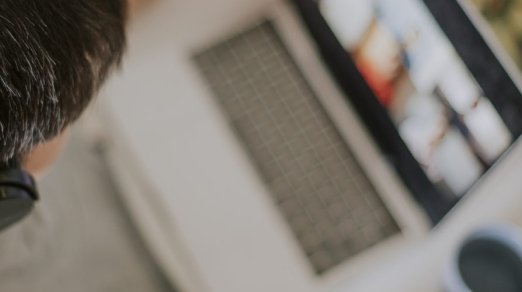Future of cities: The view from the Microsoft Technology Center
IN BRIEF
- 3:50 – Connectivity will be key: “I think we’re really starting to see the end of the office as we know it. In place of that we’re going to see more people permanently working from home. So, the question then becomes: how can you have the same experience at home that you would in the office? It’s happening now but by 2030, it will be a major trend."
- 10:05 – Infrastructure and the internet as a universal human right: “when it’s commoditized, can really go a long way to levelling the playing field. So, I think a lot of the investments in infrastructure are really designed to help start closing some of these income and performance gaps that we currently see.”
- 21:12 – So close and yet so far: “You’re going to see this idea of community, emoji and technology merging in a way that even if we are remote, we’re going to be closer than ever. In the future, you’re going to see a stronger sense of community, but also more virtualization coming together in some unexpected ways."
In this video, Kathie Topel, a Director with Protiviti’s Business Performance Improvement practice, interviews Charles Drayton, the Chief Technical Architect and Healthcare and Life Sciences Lead at the Microsoft Technology Center in Chicago where he helps customers transform the way they engage their patients, employees and partners. Charles shares his views on healthcare, real estate and demographic shifts spurred by COVID, and introduces his special guest Pria, a healthcare robot. Watch above.
FUTURE OF CITIES: THE VIEW FROM THE MICROSOFT TECHNOLOGY CENTER - Video transcript
Joe Kornik: [Music] Welcome to the VISION by Protiviti interview. I’m Joe Kornik, Director of Brand Publishing and Editor-in-Chief of VISION by Protiviti, our new quarterly content initiative where we put megatrends under the microscope and look far into the future to examine the strategic implications of big topics that will impact the C-suite and executive boardrooms worldwide. In this, our first topic, The Futures of Cities, we’re exploring the evolution urban areas are undergoing post-COVID and how those changes will alter cities over the next decade and beyond. Today, I’m joined by Kathie Topel, a Director in Protiviti’s Business Performance Improvement Practice, and Charles Drayton, the Chief Technical Architect and Healthcare and Life Sciences Lead at the Microsoft Technology Center in Chicago where he helps customers transform the way they engage their patients, employees, and partners. Kathie is going to be doing the interviewing today, so I’m going to turn it over to her to begin. Kathie, it’s all yours.
Kathie Topel: Thanks, Joe. Welcome, Charles. I’m so glad that you could join us here today. I will just start off by saying if you could tell us a little bit about the Microsoft Technology Center and what your actual role is there.
Charles Drayton: Yes. At the Microsoft Technology Center, I am the Chief Technical Architect in the Chicago Office. I’m also the Worldwide Healthcare Experience Lead for all of the MTCs. So, what the MTC is, as a Microsoft Technology Center, think of it as a people, place, and process. So, when it comes to people, we have an entire team of technical architects who cover the entire breadth of Microsoft technology. When it comes to places, there are places like the MTCs, and we have about 40 of them, or more than 40 of them, worldwide. In each place, we have a number of replica facilities. In Chicago, for example, we have a replica healthcare space that looks just like a hospital and that is designed to showcase not just the future of technology, but some of the technology innovations that we’re doing today that customers can take advantage of. When it comes to process, we can help organizations with a wide variety of subjects. We manage hackathons. We can do architecture design sessions. We can do strategy briefings. We can give you demonstrations of brand-new technology or existing technology. So, there’s quite a bit that we do at the MTCs.
Kathie Topel: Charles, when you hear the topic “Future of Cities in 2030 and Beyond,” what’s the first thing that comes to mind for you?
Charles Drayton: I think there are probably two things that come to mind to me. First is sustainability and the second is connectiveness. So, sustainability, I think anyone who’s been following the news, you understand that one of the big challenges of our time is on sustainability, green energy, the environmental crisis that we have right now. I think we’ve taken our eye off the ball a little bit with what’s happening with the pandemic, but I think very soon, it’s coming back to the forefront. So, in 2030, I think there’s going to be the end result of a significant push towards building the future city in a way that can be energy efficient, that can be self-sustaining. Things that can be green in nature that not only are designed to be zero emissions but to be negative emissions, and it’s actually one of the things that we’ve committed to doing at Microsoft with our Microsoft campus in many of the offices that we own.
The second thing is connectiveness. I think increasingly, you’re starting to see the end of the office as we know it, and in place of that, we’re going to see more people who are permanently working from home. So, the question then becomes, “How is it that you can have the same experience at home that you would in the office?” We’ve already seen a trend towards that in the past several years, and I think by 2030, that’s going to be further accelerated to the point where a vast majority of people are most likely going to be primarily working out of their homes. So, I think having a connected hybrid virtual sort of space is going to be a major trend that you’re going to see by 2030.
Kathie Topel: We all know that the pandemic has impacted our thoughts of the future. What pandemic outcomes do you believe have altered the current view of the future of cities and beyond versus, let’s say, a pre-pandemic view?
Charles Drayton: Yes. I hinted at this with my previous answer a little bit, and I’m not going to say the office concept is fatally wounded. I think the office is never going to go away, but I think there’s going to be a significant shift in how people work. We’re going to see more of a shift towards a hybrid workplace where you have some people who are working in the office and some people who are working from home. That’s definitely going to be something that has proven to be successful during the pandemic when people were forced to do it that I think it’s here to stay. The other thing you’re going to see is as a result of that, you're going to see a fundamental shift in urbanization.
So, I think the trend — it’s funny how this works, where there’s always this migration path that goes from cities to suburb, suburbs to cities, cities to suburb, and it seemed to vary from generation to generation. I think what we were seeing, up until the pandemic, was a move away from the suburbs back to the cities. You started seeing these revitalizations of urban areas and downtown areas, and now, I think it’s trying to see the reverse of that again. The pandemic, I think, has forced people or compelled people to start thinking, “Hmm, maybe I need more space. If I’m going to be stuck with you, [Laughter] in that limited square feet all day every day, maybe we get a bigger bedroom,” right? So, I think we’re starting to see a move now towards more suburban areas, more rural areas. You’re seeing people now who have vacation homes. You just think, “My lake house might not be a bad place to live permanently.” I think you’re going to see something about permanent, or at least for this generation, shift towards that, but I think with that is going to come more demands for better infrastructure to support high speed internet in some of these places to support more services in some of these places because increasingly, they’re going to find that becomes a permanent location for a lot of people to do their business out of.
Then, finally, it’s going to quicken the development in general of rural areas. I think with some of the demographic shifts that are taking place where you see millennials and Generation Z people now moving out of places like San Francisco and moving more to rural areas, you’re going to see a quickening of the development of those areas than I think they had originally had planned because of the fact that they’re going to bring their job demands with them and there’s going to be a shift in labor force and labor demands that match that as well.
Kathie Topel: I know infrastructure has been in the news a lot lately. Multiple bills are being debated around making investments in infrastructure and modernizing large parts of our country. What do you see as a relationship between the future of infrastructure and the impact it will have on cities of the future?
Charles Drayton: Yes. I think there’s going to be kind of three things that we’re looking at. The first one is going to be, as I mentioned before, sustainability, connectiveness, so I talked a bit about that initially, but I think those are going to be key pillars of infrastructure. I think any investment in infrastructure, regardless of what happens with the bill currently being debated right now, it’s all going to come back to how it is that we’re able to narrow the gap between urban areas and rural areas. I think for a long time, the development in technology and development in the infrastructure in these urban [areas] has caused the development of that to outstrip the development of rural areas. I think in many respects, they’ve been left behind, but I think if this infrastructure thing works out, you're going to see a lot of investments in rural areas to really bring them more in line with what urban areas developed or with what urban areas have to offer now.
So, it’s going to be appealing to younger generations who, I think, are already starting to move to areas like that, and it’s also going to, I think, narrow everything from the education gap to the development gap, and this is something that is particularly powerful for minority communities or for poor communities who typically are over-represented in rural areas. I think it’s going to create more opportunities for them. I think it’s going to create a somewhat more equitable future if this is pulled off the way I think everyone is hoping for it to be. I think part of that, part of the end results of that is going to be things like the dispersing of the workforce.
So, once you have infrastructure available, that you have high speed internet in both urban areas, suburban areas and rural areas, I think it’s now going to make for a, I think, safer and more comfortable environment for generations of knowledge workers, and you’ll find that knowledge workers are increasingly outstripping a lot of the former blue-collar workers as those jobs start to shrink and you’re going to see that replaced with more of a knowledge-based workforce. The third, I think, is going to be finally starting to look at the internet as a commoditized utility.
I think for a long time, we saw that as luxury, and because we saw it as a luxury, it was difficult to think of it as something that was a driving force behind things like income inequality or performance differences within different communities. Like, why is it certain neighborhoods tend to have students perform better than others, and I think we’re starting to see research now that says the internet as a universal human right, is something that, when commoditized, can really go a long way towards levelling the playing field. So, I think a lot of the investments in infrastructure are really designed to help start closing some of these income and performance gaps that you see in a lot of these areas.
Kathie Topel: Charles, you shared at the beginning with us that the healthcare exhibit at the MTC is an amazing view into what can be possible. What influence will the possibilities for healthcare organizations have on the future of our cities?
Charles Drayton: Yes. I think we’ve already started seeing this. It’s funny, I’ve been in healthcare for a long time, and for many years, we had telehealth technology that we would try and sell to hospitals, and they will always, “No, it’s not really necessary. We don’t see ourselves as people who would ever really see patients outside the hospital or outside of the doctor’s office.” Obviously, that all changed with the pandemic, and similar to how people who had previously never really done online shopping, who are sort of resistant to it, suddenly discovers the joys of amazon.com for the first time, and they never go back because they’ve realized how easy it is. Sort of like my mother. My mother was sort of a person who would always go to the store no matter what. I’d say, “Amazon Prime.” She’s like, “But you can’t look at your groceries. Why would you do something like that?” Then, she realized she had no choice. She realized how convenient it is, and now, she can go back to the store anytime she wants; she’s not doing it.
I think it’s a very similar thing now where hospitals are beginning to realize that actually virtual care isn’t so bad. Actually, there are great opportunities to create a continuum of care that takes place. So, not only can we care for the patient when the patient is within our four walls, but we can continue the dialogue and we can continue the monitoring of the patient even after the patient is discharged or even after the patient leaves the doctor’s office, because many things that happen with the patient that will lead to complications, that will lead to readmission takes place after their discharge. Did they refill their prescription? Did they take their medication? Are they following through on post-discharge instructions? You had no real way of verifying that traditionally, but now with virtual care and ability to combine that with things like continuous vitals monitoring and having that sort of connected ecosystem of health makes it much easier to start getting a lot of these early signals from patients. So, is a patient taking 45 days to refill a 30-day prescription? If so, I want to know about that so I can do an outreach with them. If we have rehab, some sort of physical rehab for the patient and they have some sort of connected watch, are they taking the requisite number of steps? If they’re not, I want to know about that because it may mean that they’re not really following through on the post-discharge instructions. Are they weighing themselves regularly because they have to get their weight down to a certain level in order to qualify for a specific type of surgery? Are they on track to do that? A lot of these things take place at home, and increasingly, hospitals and healthcare organizations are realizing that and they’re starting to make more investments into it.
So, going back to this idea of future cities, when we start looking at the commoditization of the internet as a whole, and now, making internet available at little or no charge in all kinds of rural communities. Now, when you look at these underrepresented communities in terms of the number of hospitals that are there or the number of stores that are there that sell fresh foods, we’re now able to extend our ability to care even out to them. I think that’s another way of beginning to close the gap that has historically existed between vulnerable communities that are often rural communities, or even urban communities that aren’t close to hospitals or to fresh food sources and how do we bring that care to them to create a more equitable environment for wellness overall.
Kathie Topel: With the virtualization of collaboration, it’s changed the way we socialize, work, and live our lives. The ability to collaborate and share from anywhere allows each of us to make different choices now. How will these different choices impact real estate and what role might technology play a new trend to emerge for cities?
Charles Drayton: [Laughter] So, I’m glad you… it’s a very timely question you asked. I’ve been looking for some income property for a while. I believe, to diversify a little bit, and so I’ve been looking for these sort of multi-unit places and I’ve been consistently outbid anywhere in the south. Like, I cannot buy a home in Dallas. I cannot buy a home anywhere in Georgia. Every time I try, I’m sort of outbid by these all cash offers that are like 10% over asking, and I say that to say, from a real estate standpoint, people understand the fact there are some significant demographic shifts that are going on in terms of where people are moving and how people are living. I think some of the things that you’re seeing now are being manifested in this kind of rush for purchasing real estate in warmer climates or in more suburban areas and rural areas, and I’m definitely feeling the results of that. I think it’s going to lead to more demand for better infrastructure. Similar to some things I have been talking about throughout our conversation here, the demand for high-speed internet everywhere. So, not just in downtown Chicago do we get gig internet, but how do we get it everywhere and where does it show up everywhere because you’re going to see more of these virtual calls. So, I think you’re going to see increased support and demand for investment in infrastructure as we start seeing, from a real estate standpoint, more and more families moving to areas where, traditionally, they haven’t been. Those are some of the things from a residential standpoint that you’re going to see as a change or a shift when it comes to real estate. From a commercial standpoint, I think one of the things that you’re going to see is, I’m going to call it an urbanization of the suburbs.
So, as people start moving out into rural areas more and they start moving out to suburban areas more, you’re going to see a move away from urban areas of commercial offerings and bringing them more into suburban and rural areas. So, as Generation Z-ers and Generation Y, people tend to go, you’re going to see more restaurants and shops open up around them. So, you’re going to see a decrease in demand for commercial real estate perhaps in urban areas, but if you’re going to see an increase in demand for commercial real estate in some of these suburban areas as you start providing some of the comforts of the urban environment that they moved from into suburban environment. So, you’re going to start seeing perhaps — these are all of the guess that I have — the shrinking of major cities, and instead, the growth of these many metropolises in some of the satellite areas. I think that’s where a lot of commercial real estate opportunity is going to be. I think you’re also going to see a fundamental shift in retail as you’ve been seeing already, and this is just sort of exacerbated things a little bit more, but in really interesting ways.
So, I’ve worked with a couple of commercial of real estate companies and one of the things that they were sort of excited about with this is this shift away from malls as being places where you go and shop to malls as being centers of recreation, particularly around many of the suburban and rural areas where it’s not simply a place where you have these stores, but it’s kind of your work/play area. I think you’re going to see a resurgence of that in some of these rural places as organizations start creating these kind of satellite metropolis cities out of what were formerly fairly barren rural areas.
Kathie Topel: Charles, if you can leave our viewers with just one thought of “The Future of Cities for 2030 and Beyond,” what would that be?
Charles Drayton: I want to show you a little something here. I like to introduce you to Pria. Pria is a robot and Pria is something that was initially designed by a company that was acquired by Stanley Black & Decker. What Pria does is she’s a pill dispensing robot, and a pill-dispensing robot can do everything from having virtual meetings with the physician to dispensing pills, to monitoring your vitals. So, if there is a spike in something, if you have AFib, she’s able to give you an early intervention and say, “Hey, this might be something that is potentially a medical emergency.” I think Pria, and things like Pria, are going to be increasingly key components of the future, and that’s from the healthcare standpoint. I did something recently that talked about this idea of senior isolation. The fact that senior homes couldn’t get visitors for a full year, I mean that lead to a mental health crisis within senior homes, and one of the ways that we talked about addressing that was through senior gaming.
So, there are gaming leagues that are formed in places like Pennsylvania that create this virtual community among seniors where they can be connected to each other and to their loved ones, and to everyone else, even if they can’t physically be there. So, increasingly, you’re going to see this idea of community emoji and technology starting to be merged in a way where even if we are remote, we’re going to be closer together than ever. I think those are really good examples of that. So, my thinking is in the future, you’re going to see a stronger sense of community, but you’re also going to see more virtualization. So, you’re going to see the combination of the two of them in very unexpected ways, or since it’s 2030, I can be entirely wrong about all of it because technology moves that fast.
Kathie Topel: Thanks so much, Charles, for your insights here today and your participation. We truly appreciate it, and you brough us so many ideas for the future and we’re very, very excited for it. Thank you.
Joe Kornik: Thanks, Kathie, and thanks, Charles. Charles, a real rock star, brings his own visual aids with him, some real estate advice, and a little couple of jokes thrown in there for good measures. So, we always appreciate that levity, Charles. Thank you so much for your time today. We appreciate it.
Did you enjoy this content? For more like this, subscribe to the VISION by Protiviti newsletter.




































